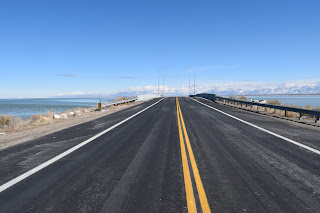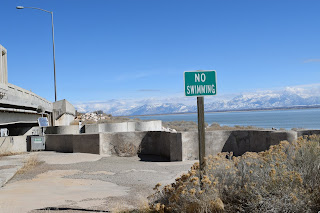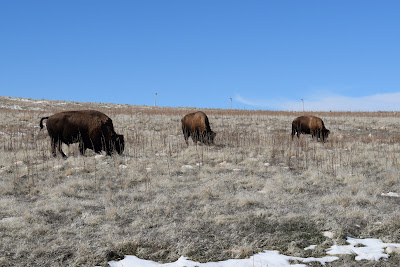Kristi agreed that it was a good idea to try to get to the lake somehow and we got in our car and started to drive. It was a chilly winter day. No matter, we were determined to see the GSL close up. We drove through town (we were staying in Layton) quite a distance, but it all seemed like the same suburban town, and as we got closer to the lake there were new housing developments, and lots, and lots of shopping. Then there was a road and a gate, and a guard shack where we were asked for an admission fee, which being seniors (over 62) was $5. Now, mind you, we still had no idea what the park consisted of. Once we got past the gate guard we were on a causeway, a lake fill with a road on it and we drove the 7 miles out to Antelope Island.
Once on the island we found a place where there was beach access and walked across a rocky terrain down to the beach where we admired the sun trying to shine through a gray winter sky. There was sand of a texture that I had not experienced before, and the lake water was calm. There were snowy mountains on all sides of the lake, and a bison standing on the beach.
The 7 mile causeway was built started in 1967, and finished in 1969. On the way out the causeway for our first time we saw several hawks hunting in the grasses by the road. The water was low for much of the way with a snowy beach that extended out quite a ways. As we got closer to the island the water got higher. We crossed two bridges on the way out that allowed water to flow from one side of the causeway to the other.
After a short stay on the beach we visited the "visitors center" where we found out a little more about the island. The island had been a ranch since 1848, and most of the game that was originally on the island had vanished and the native grasses had been destroyed by grazing cattle and sheep. The state bought the ranch in 1981 and restocked the island with California Bighorn Sheep, and pronghorn antelope, There has been a bison herd on the island since 1893 when a dozen bison were purchased from one William Glassman by then owners John White, and John Dooly and there has been a Bison herd on the island ever since. The herd now numbers between 500 and 700.
After the "visitors center" we drove out to the aptly named "Buffalo Point" where we saw our first bison. There is a nice view from there. As I said before it was a chilly day, and it was 4 pm when we got there. By this time it was after 5 pm and the park closes at 6 pm so we were thinking it was time to call it a day.
 |
| Our First Bison Sighting |
The ranch was sold to various people over the years and was primarily a cattle and horse ranch until 1915 when the owner changed to sheep ranching. All of this depleted the native vegetation which is currently being restored. The park is "home to jackrabbits, pronghorn, bobcats, mule deer, coyotes, and several species of rodents. The island and Great Salt Lake attract migrating birds. The inland grasslands on the island provide habitat for chukars, burrowing owls, long-billed curlews and several species of birds of prey"
If you look closely at these pictures you can see where this ranch house has been built onto. At the very end of the house is a bathroom with a shower and and indoor toilet. Improvements came slow to the island. There is documentation describing the introduction of electricity to the island, how they subsisted before there was electricity etc.
 |
| If this raven turned around you would see a small mouse in his beak. |
As we were leaving the Island after our second trip out there we stopped at the first bridge you cross after leaving the island. I got out of the car and walked along the bridge because I wanted to see just how much water was being allowed to go under the bridge. I also wanted to take a few pictures. When I got back to the car Kristi was out of the car carrying her camera. She had seen a coyote crossing the bridge. [ (from Kristi): Steve had just asked the rhetorical question of whether animals ever make their way from the mainland out to the island on the causeway. So there was our answer. This coyote was trotting past our car, right down the center line of the asphalt and tempting fate. I was fearful of it's safety as a car came along and slowed for it, then followed by an impatient truck-driver. The coyote survived, apparently by following the shoreline by the causeway. Here was an example of an animal who decided this life wasn't destined to be home sweet home and was making his exit.] Driving off of the island we almost ran into a big hawk with about a 4 foot wingspan.
 |
| Coyote Alley |
Driving out to the island on Wednesday we stopped at the bridge again. I wanted to take an even better look at the water under the bridge, The water was a bit murky, but I was able to get a look at some of the plant life, which seemed to have some appeal to me.
Going onto the island we got a closeup look at some bison. We took some pictures from the road. They really didn't pay much attention to us, neither posing, nor going away from us. They remained intent on feeding themselves. There must have been some good food there. We observed some birds that were apparently finding something good to eat on the backs of the bison.
 |
| Birds on Bison |
Kristi asked me what this thing on the Fielding Garr Ranch was:
 |
I found this sign on the wall of the shop. |
For a synopsis of island history: https://stateparks.utah.gov/parks/antelope-island/antelope-island-history/
I hope you enjoyed reading. Kristi and Steve Nebel


















"What an amazing Odd-y-sea!" All the strangeness of finding bison and coyote in the middle of Great Salt Lake
ReplyDeleteand the remoteness. I think the Key Peninsula is much more dangerous -someone is always getting murdered there. Where this seems deserted and derelict. The coyote in the middle of the road must be some kind of political statement don't you think?
I guess that character was either an emigrant or an immigrant, leaving because he felt unwelcome. Astute, I think, Mike!
ReplyDelete